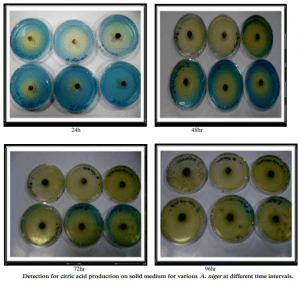THEORY
Nowadays, citric acid (2-hydroxy-propane-1,2,3-tricarboxylic acid) is produced microbiologically by Aspergillus niger and Aspergillus wentii. The most important carbon source for citric acid production is glucose. Some of the glucose is used for mycelium growth in the trophophase, while glucose is used for citric acid production during the idiophase.
OBJECTIVE
Aspergillus niger on Petri plates
REQUIREMENTS
- Pipette, sterile pipette tips
- Burker chamber
- Inoculating loop
- Broth for citric acid production (see Appendix)
- Shaker incubator
- Incubator
- Thin layer chromatography (TLC) plates (silicagel, 5×4 cm in size)
- Microcapillary
- Glass developing tank for running TLC
- Forceps
- Hairdryer
- Solvent mixture (benzene:methanol:acetic acid in ratio 45:8:4)
- 1% citric acid solution
- Schweppe’s reagent
- Laboratory oven (125°C)
PROCEDURE
1. Transfer Aspergillus niger spores from an agar slant into two tubes containing sterile distilled water using an inoculating loop.
2. Using a Bürker chamber, set the spore concentration of the suspensions to 20,000 and 80,000 spores/mL, respectively.
3. Add 1 mL of each spore suspension into separate Erlenmeyer flasks containing 50 mL nutrient media for citric acid production.
4. Shake the flasks at 37°C for one week at 270 rpm.
5. Demonstrate the citric acid production by thin layer chromatography (TLC): spot the plate with samples and 1% citric acid as control using a microcapillary. Put the TLC plate into the glass developing tank containing the solvent mixture. Run it four times and dry the plate with a hairdryer after each run. Spray Schweppe’s reagent onto the TLC plate and incubate at 125°C in an oven for 5 minutes. Citric acid will appear as a brown spot on the TLC plate.
6. Compare the results of the two different spore concentrations.

